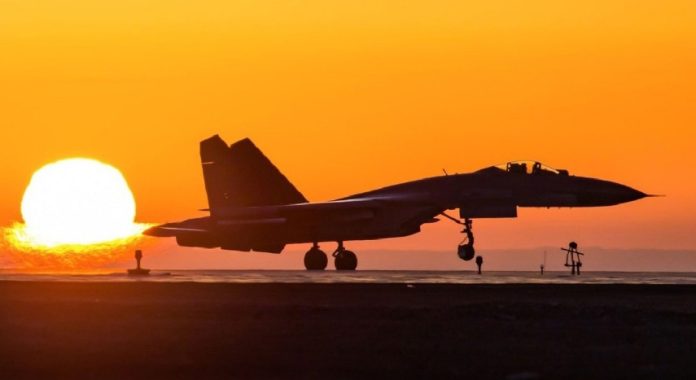The superiority of Russian Su-35s over Ukrainian aircraft explains why the Ukrainians insist on Western allies buying fighters such as F-16s, The National Interest reports.
The outbreak of war in Ukraine in 2022 has renewed interest in Russian military technology. Russian military technology commands some respect from Western observers, although Russia does not pose the threat to US interests that Washington once believed it did to the Soviet Union. Aerospace design is one area where the Soviets, and now the Russians, have always excelled. It is no accident that the Soviet Union outperformed America in almost every significant stage of the space race (with the exception of the moon landing). Soviet success was well-deserved, and as a result, Russia is now known for its powerful and developed aerospace industry.
However, times have changed. America has come almost on par with Russia and China in terms of quality and quantity of aerospace products. But Russia still has a powerful fleet of fighter jets – certainly enough to make America think twice. And one of the fundamental arguments for Russian air superiority is the Su-35 fighter.
The Su-35 is a modified Su-27. The latter entered service in 1977, when the Soviet and American armed forces were in an arms race and the two countries’ aerospace developments were keeping pace with the times. The Su-27 was a direct response to the just-released fourth-generation American large fighters, the F-14 and F-15. Both the F-14 and F-15 were twin-engine, highly manoeuvrable aircraft capable of carrying heavy munitions over long distances and equipped with sophisticated avionics, according to The National Interest.
The combat missions of the original Su-27 variant, like the F-15, were air superiority missions – before subsequent variants were modified to fulfil a broader mission profile.
The Su-27 entered service in 1985 and was used for two main purposes: firstly, long-range air defence against US bombers such as the new B-1B and the decades-old B-52, and secondly, long-range escort of Soviet bombers such as the Tu-95 and Tu-160.
Subsequently, many modifications of the Su-27 were produced. The Su-30 is a two-seat multirole fighter based on the Su-27; the Su-33 is the Su-27’s aircraft-carrier brainchild; the Su-34, another Su-27 derivative, has two seats side-by-side and is used as a fighter-bomber; a thrust vectoring version of the Su-27, the Su-37, was developed; and, of course, the Su-27 gave rise to the Su-35.
The Su-35 carries the N035 Irbis-E “Snow Leopard” passive electronically scanned array (PESA) radar. The N035 is an improved version of the N011M radar and can detect an airborne target up to 250 miles away. The N035 can track up to thirty air targets simultaneously and engage eight air targets simultaneously. The N035 is also capable of transmitting high-resolution images of the ground to the pilot in synthetic aperture mode (synthetic aperture mode is a type of radar that produces two-dimensional images or three-dimensional reconstructions of objects, such as a mountain range below).
For defence, the Su-35 uses the L175M Khibiny-M electronic countermeasures system. In addition to the N035, the Su-35 is equipped with the OLS-35 optoelectronic target designation system, located in the nose of the cockpit and providing search and tracking in the infrared range. The aircraft is fitted with radio-absorbing materials on the engine inlets and on the front stages of the engine compressor to reduce the Su-35’s radar cross-section. As a result, the radar cross-section has been halved. However, the Su-35 is not a stealth aircraft, not like the F-22 or F-35, The National Interest reports.
The Su-35 is powered by two Saturn AL-41F1S turbofan engines. The Saturn engines on the Su-35 have thrust vectoring nozzles, which provides super manoeuvrability, just like on the F-22 and F-35. As Sukhoi’s chief test pilot, Sergey Bogdan, explains:
“The classical air combat starts at high speed, but if you miss on the first shot – and the probability is there because there are maneuvers to avoid missiles – the combat will be more prolonged. After maneuvering the aircraft, will be at a lower speed, but both aircraft may be in a position where they cannot shoot. But supermaneuverability allows an aircraft to run within three seconds and take another shot.”
Thanks to its super-maneuverability, the Su-35 can perform post-stall manoeuvres at low speeds, which is in marked contrast to the Western philosophy of manoeuvring in air combat, which focuses on preserving the aircraft’s kinetic energy.
The Su-35 has been deployed in the skies of Ukraine. While performing air superiority missions, the Su-35 has scored no less than seven air combat victories against Ukrainian jets (and one against a Ukrainian Mi-14 helicopter). Several Su-35s are known to have been shot down over Ukraine. This is why the Ukrainians are so insistent on Western allies acquiring Western fighter jets such as the F-16.
